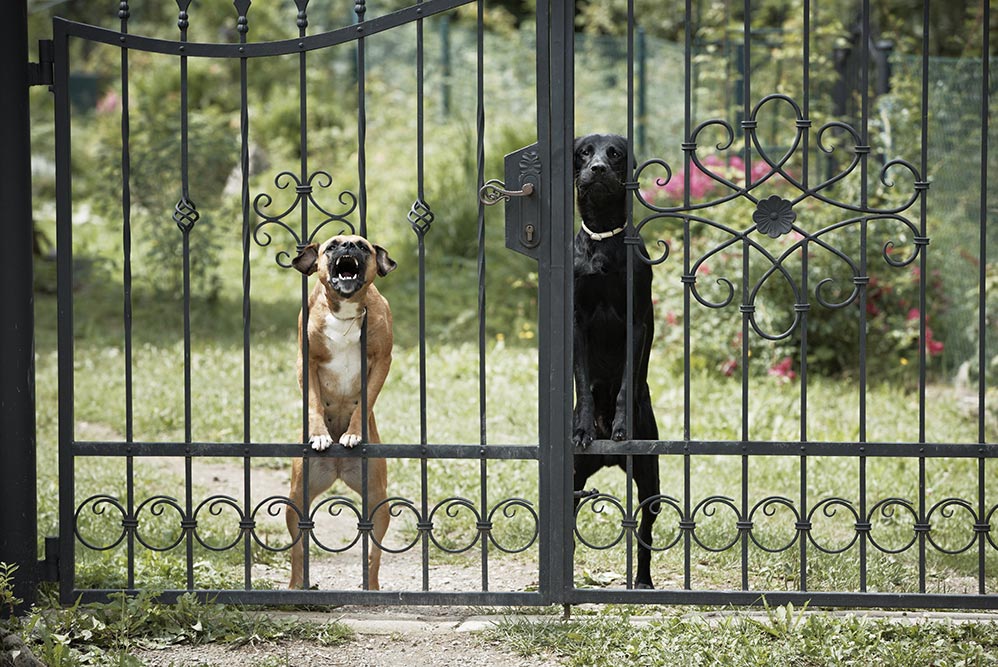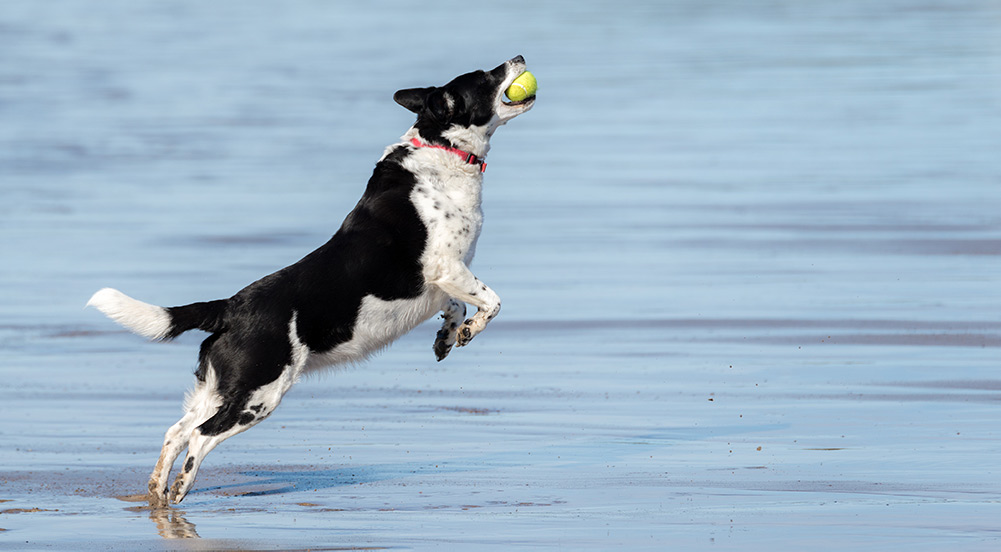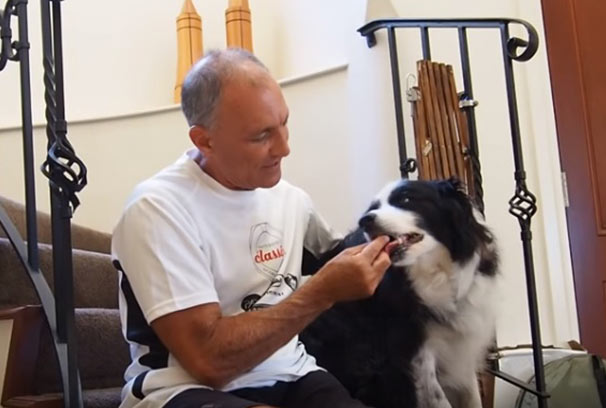How to stop a dog from barking
One of the questions most frequently asked by dog owners is how to stop a dog from barking. Statistics suggest that excessive barking may well be the most significant behavioural issue confronting dog owners, and in Australia, barking is the second most common complaint made to local councils. Continuous and excessive barking can indeed be highly problematic for dog owners and their neighbours alike.
It is important to understand that barking is a natural behaviour for dogs. They are social animals who interact with one other, and with us humans, through vocalisations and body language. Dogs have a wide range of vocalisations – apart from barking, they whine, growl, howl, whimper, yip and yelp. We cannot expect dogs to be silent when vocalising is part of their nature; however, there is a difference between ‘normal’ and acceptable levels of barking, and continuous, excessive barking that disturbs the peace and causes discomfort for those in hearing range.
Why do dogs bark?
We know that in the wild, dogs bark to communicate, particularly when they cannot immediately see the rest of the pack or when they want to get a message to the entire pack – a warning of danger, a call to the hunt or a way to scare off a threat. Domesticated dogs live in a very different world from their wild ancestors, but their instincts and drives remain very much the same. Often, their barking is a perfectly natural canine response to a stimulus in the environment, such as another dog passing by or a stranger knocking on the door. They may also bark when they are exposed to new or unusual stimuli, including sounds, sights or odours, during times of indecision, anxiety, or frustration, and when in pain or discomfort. Some dogs also bark because they are excited and sometimes, they may appear to bark without any obvious reason at all.
Barking as an alert or alarm
Alert barking can occur in response to real threats (for example, a dog or stranger approaching) or to a stimulus (a noise or unfamiliar object) that has startled or excited the dog. Short, sharp and repetitive, the purpose of the alert bark is to call out to his pack or his people to join him in the face of an emergency, much like a siren or an alarm would, thus its intensity is difficult to ignore. The dog may peer out the windows, tilt his head and try to locate the source of the disturbance. Alert barking can happen anywhere, not just at home.
For hundreds of years, humans selected dogs purposely for their ability to alert and it was a highly desirable trait. Nowadays, in many parts of the world, society is very different. High- and medium- density urban living doesn’t encourage alert barking anymore but the genetical roots are deep for this behaviour in the dog.
Barking as a threat or territorial warning
A threatening bark is sending a territorial warning to let non-pack members know that this is his territory and he’ll do anything in order to protect it. The barking often gets louder and harsher as the threat gets closer, and the dog looks alert and aggressive. This type of barking is common behaviour in the many guard dog breeds. Protective and guarding instincts have been honed over hundreds of years in these breeds, so it is no wonder that they bark at strangers or other animals approaching their homes. Guarding breeds prone to this type of barking include:
- German Shepherd
- Doberman Pinscher
- Rottweiler
- Bullmastiff
- Schnauzer
- Boxer
- Rhodesian Ridgeback
- Akita
- Belgian Malinois
- Komondor
- Cane Corso

Barking when experiencing separation anxiety
Separation anxiety can occur when a dog who is very attached to his owner is left alone at home. In addition to continual barking, a dog that suffers from separation anxiety may howl, whine, pace intensely and engage in destructive activities such as chewing on furniture, frantic scratching on doors or windows and ripping up pillows or clothing.
The excessive barking and destructive behaviours associated with separation anxiety are an attempt by the dog to relieve his stress, and they typically happen every time the owner leaves and only in his or her absence. Sometimes, they may begin even before the owner leaves, for example when he or she put on a coat or takes out the car keys. In many cases, however, these behaviours begin soon after the owner leaves, and he or she may be unaware just how distressed their dog is, and how persistent his barking is, during the periods of absence.
Separation anxiety can occur in response to major changes in the environment, for example, moving to a new house, a family member leaving the home or a new one joining the home, or even a sudden change in schedule. While all breeds can suffer from separation anxiety, some breeds appear to be prone to it, especially the more people-oriented breeds, including:
- Labrador Retriever
- Chihuahua
- Border Collie
- Cavalier King Charles Spaniel
- Jack Russell Terrier
- German Shepherd
- Cocker Spaniel
- Australian Shepherd
- Bichon Frise
- Vizsla
- German Shorthaired Pointer
- Toy Poodle
For tips on how to avoid separation anxiety, see here.
Barking when experiencing fear
Dogs may bark excessively when startled, afraid, uneasy or stressed. Barking is a way of dogs to communicate to the threat to move away, e.g. when dogs bark at an unusual item or person on their walk. Many dogs are frightened during noisy events such as thunderstorms or fireworks and will bark excessively in response.
Barking when bored or lonely
Barking to communicate feelings of boredom, unhappiness or frustration can occur when the dog is alone at home or confined to the backyard with not much to occupy himself. This behaviour can often be seen in dogs that have been selectively bred for working dog roles either directly or through their close ancestors, when they are left without a job for long periods at the time.
Dogs are pack animals who enjoy interacting with their humans and/or other dogs. A dog who is howling is thought to be a calling out to those around him that he is alone and desperate for some company. Dogs that are really bored might bark to just entertain themselves – they might not be barking at anything at all, just barking because it’s less boring than doing nothing. Some dogs bark non-stop whenever they are outside, because of a lack of stimulation – barking is their way to release excess energy.
Barking when seeking attention or wanting something
Dogs often bark when they want something, such as to be let into or out of the house or to be fed. They may also bark to get attention from people. Dogs learn quickly that barking at people often makes those people give them what they want, which quickly creates a strong habit of barking to get what they want. This type of barking can be constant and non-stop, causing much frustration for owners and neighbours.
Barking when excited
Dogs bark when expressing their excitement, particularly when a family member arrives home, when they are playing, or when they encounter other dogs in their social group. In these situations, barking is a greeting, a happy bark accompanied by a wagging tail and sometimes jumping.
Barking in response to other barking
Some dogs will bark excessively when they hear other dogs barking. This kind of barking occurs in the social context of hearing other dogs, even if they are far away, such as dogs in the neighbourhood.
Barking because of frustration
Some dogs bark excessively when they’re placed in a frustrating situation, for example, when they are separated from their playmates, or when they’re confined or tied up so that their movement is restricted, or when they are on leash.
Barking because of illness or injury
Dogs sometimes bark as a consequence of pain or a painful condition. Before attempting to resolve your dog’s barking problem, please consult your veterinarian to rule out medical causes.
Some dogs bark more than others
All dogs bark, except perhaps for the Basenji, who are known as the “bark-less dogs of Africa”, although they do vocalise with screams, growls and a canine yodel! Some breeds are more excitable and impulsive than others, and many of these have a strong disposition towards excessive barking. By nature, they are very vocal with their barks, howls and yaps, and even with professional training it may be impossible to get them to stop barking.
Many working dog breeds were bred to bark because of the job they were required to do. From herding, to flushing out game for hunters, to alerting people to danger or the presence of intruders, many breeds such as Beagles, German Shepherd Dogs and Shetland Sheepdogs were bred in part for their barks.
Breeds that tend to bark more than others include:
- Chihuahuas, who have a tendency toward yapping that can be triggered by separation anxiety and potential threats. They are territorial and don’t like others entering their private space, and they get uneasy when someone gets too close to their favourite humans.
- Yorkshire Terriers are also yappers who find it difficult to be silent, even with proper training and plenty of distractions. They are territorial, energetic and highly protective – traits which together can lead to almost constant barking.
- Jack Russell Terriers love to bark, and a lot of patience, training and dedication (as well as some good earplugs!) are required from their owners to manage this effectively.
- Other Terrier breeds are also very keen on vocalising – the Boston Terrier, Scottish Terrier, Cairn Terrier, West Highland White Terrier, Fox Terrier, and Silky Terrier are all known to be enthusiastic barkers.
- Basset Hounds have a classic hound howl that can be heard for miles around when they are left alone at home. As tracking dogs, they have been bred to bark when they suspect that something or someone is nearby.
- Miniature Schnauzers are also more likely to bark or yap constantly. They may do so to protect their families and ward off intruders, to assert their dominance or to express their boredom.
- Beagles are generally pretty ‘talkative’ but aren’t usually nuisance barkers unless they are bored or lonely.
- Keeshond are very protective of their families and like to alert bark whenever something is coming their way. If out in the backyard they will bark almost constantly.
- Maltese are a feisty breed who will bark at pretty much anything and everything they encounter, including visitors to your home.
- German Spitz are a vocal breed who often bark loudly and sometimes howl, especially around people they don’t know.
- Pomeranians are well known for their yappy bark. Poms generally bark a lot, and for all sorts of reasons.
- Schipperkes are often quick to sound the alarm or to bark for entertainment.
- Samoyeds love to bark. They have intense, high-pitched barks that can be very annoying for both their owners and the neighbours.
- Finish Spitz are also known as Bark Pointers for a good reason – barking is a major part of their hunting activities; it is something they were bred specifically to do.

How to stop a dog from barking
A more realistic question than this is “how to reduce the incidence, intensity and duration of barking?”. Ideally, in most cases barking should serve to get the dog’s intended message across, then cease. Because there are so many possible underlying reasons for the barking, there is no one simple solution to reduce barking behaviour. Getting your dog to bark less will take time, patience, effort and consistency. Sometimes, your best efforts may not produce the desired result, and you may need to engage professional help.
Identify why your dog is barking
What event occurred immediately before the barking began? As we’ve seen, in many situations barking is a common canine response to a stimulus – the doorbell ringing, the owner leaving, meeting another dog in the park, a loud noise… Be aware that sometimes, the stimulus is so strong that it would be really difficult or even impossible to stop the barking entirely. This is particularly the case in breeds in which barking was encouraged over hundreds of years as part of the job they were bred to do.
If no identifiable stimulus appears to precede the barking, could it be a response to being left alone outside, boredom, or lack of stimulation? Or perhaps the dog is responding to another emotion such as fear or anxiety (these may be trickier to identify without professional advice). Or is the dog seeking your attention – is he trying to tell you that he is hungry, cold, or wanting to go for a walk?
Dogs don’t really bark for no reason, so even if you cannot determine the cause, it is likely there is one that you are just not aware of. For example, noise sensitivity can be a trigger for barking, or you may have a possum in the attic that you are unaware of, but the dog is and alert barks to try to tell you.
Interpret what your dog is “saying”
What is your dog is trying to communicate to another dog or person, or to you, his human pack leader? When your dog vocalises with barks, growls, yips and yelps, he is sending out different messages that could be happy, fearful, demanding, angry or questioning.
Try to become familiar with your dog’s range of barks, as well as their pitches and frequencies, because this knowledge can help you to decode the message he is trying to convey. For example, his panicked bark will sound different to his bored bark which will sound different to his greeting bark. Try to recognise the difference between the excited ‘yipping’ when you get the lead out, the warning bark when the doorbell rings, and the nervous bark when he sees someone unfamiliar (if you need help, search videos and audio files of different barks for a general idea, for example, see here).
If you can correctly identify the underlying message, you may well be on track to reducing your dog’s excessive barking. After all, if you understand what he is trying to say and respond appropriately (see below for more on this), he should no longer need to keep on repeating the message.
Recognise your usual response to your dog’s barking
How do you typically react when your dog barks and barks? Owners may react in ways that are not helpful or even cause or worsen the barking. For example, in attempting to calm their dog down, many well-meaning owners give attention, play, food or affection to the barking dog, thereby inadvertently rewarding and encouraging the undesirable behaviour.
Or owners will cuddle their dog who is barking as a result of fear, for example from a thunderstorm. However, cuddling alone when a dog is barking out of fear is quite unlikely to resolve the fear in the long-term. A behaviour modification program that teaches coping skills and reduces anxiety and fear is required to aid with that. Try to ensure that your dog’s barking is not being rewarded inadvertently by your response.
Even an unpleasant reaction to an unwanted behaviour also will often encourage, rather than deter, that behaviour. In the mind of a dog barking for attention, being yelled at is attention, which is better than no attention at all. No matter how irritated you are, refrain from responding with shouting or punishment. It is essential that you remain calm and assertive. If you get angry or impatient, this may just ramp up your dog’s energy and make barking more of a problem.
Most behaviours a dog will engage in are an attempt to better their situation. This means that if you want an unwanted behaviour to stop, then that particular behaviour cannot have any success. Therefore, attention barking cannot lead to any kind of attention from you. Barking out of boredom is also a self-rewarding behaviour meaning the dog gets re-enforced just by doing the behaviour. So, to stop the reinforcement you would need to think about ways to not have the dog start barking in the first place.
How training and behaviour modification can help
In many cases, barking behaviours are often inadvertently reinforced by owners in the attempt of trying to quieten down their dogs.
The rule of thumb here is to reinforce the behaviours you like to see more of and not have the unwanted behaviours lead to success.
Just a few examples:
- If your dog barks for attention, you want to make sure you reward him with said attention when he quietly sits in front of you or lies at your feet, and not when he is barking.
- If your dog barks in the backyard because he is bored, you may provide toys and activities that relief the boredom, so he won’t feel the need to bark.
- If your dog barks because he wants you to come back to him, you may want to wait until he is quiet before you return.
- If your dog barks because he is overexcited and frustrated on the leash because he cannot say hi to the dog just 2 meters away from you, you may want to teach him to rather focus on you for an equal reward than on the dog.
Tip – if you are worried you may upset your neighbours during the process of reducing your dog’s excessive barking behaviours, perhaps leave them some chocolate and/ or wine a and a friendly note letting them know that you are in the process of training and that for a short period of time behaviours may get a little worse but you are on top of it working towards a more quiet future.
If your dog is barking because of fear related behaviours, techniques like counter conditioning and desensitisation can assist with overcoming the fear. A qualified dog trainer and behaviourist can help you to identify and implement the best strategy for your dog.
Desensitisation can also be a very helpful technique when dealing with barking related to noise sensitivity e.g. like barking of other dogs, the doorbell, neighbours walking past or plane noises being a trigger for your dog.
Increase exercise and interactive play
Is your dog getting enough exercise, training and play time? Providing lots of physical and mental stimulation is an essential component in treating many canine behaviour problems, especially those driven by anxiety. Of course, if your dog is suffering from boredom and lack of stimulation, it is also critical to provide him with more opportunities for training, play and exercise, as well as giving him tasks to do and commands to learn. These activities decrease stress, provide the physical and mental stimulation that your dog needs and burn up excess energy that he would otherwise direct towards continuous barking.
Excessive barking is often the result of pent-up energy. Increasing your dog’s physical as well as mental activity can work wonders in releasing that energy in more productive ways. If he’s not already, make sure that your dog receives a daily walk or two. If he is getting a daily walk, try to make the walk more challenging by extending the duration, changing routes every few days, visiting new places, changing the pace multiple times during the walk or including some hills in your route. If you usually walk him in the evening, introduce a morning session as well – this could make a huge difference if he’s spending most of the day alone at home. Taking your dog on more stimulating walks and outings before you leave will burn off some of his excess energy and leave him in a calmer state. Adding some obedience training or urban agility to the walk will ensure your dog’s walk isn’t just physically but also mentally challenging.
Providing him with more mental challenges, such as agility training, obedience games or a dog sport, can also be extremely beneficial in enriching his life and decreasing stress and pent-up energy. When you go out, leave him with something challenging to do, like a favourite chew toy or a “find the treat” toy that will keep him engaged for a while. When you are home, play fun, interactive games with him, like tug-of-war, hide-and-seek or fetch, and take him to new and interesting places, such as dog parks, dog beaches and nature parks which allow dogs.

Modify the home environment
Is there something you can alter or implement in your home that might help? Where excessive alert barking or territorial barking is causing a problem, sometimes the home environment can be modified so that the dog is kept away from the stimuli, particularly sights and sounds, that are causing his barking.
Some potential modifications include:
- Leaving the dog in a crate (see below) or a room away from doors and windows.
- Covering windows with curtains, blinds, or reflective films to obscure his view of people and animals outside.
- Masking or muting the sounds that stimulate barking by using music or TV for background noise, or white noise devices.
- Installing privacy fencing for dogs outdoors.
- Installing motion sensor devices to discourage cats and other animals from entering the yard.
- Keeping dogs indoors that bark when left alone outdoors, except when the owner is outside to supervise.
- Removing doggy doors if the dog barks outside and has constant uncontrolled access to the outside
Consult a professional
Have all your efforts failed to curb your dog’s excessive barking? You may need to consult with an expert in canine behaviour and problem barking. Depending on the underlying cause of the barking, in most cases a professional and qualified dog trainer and behaviourist will be able to help. In extreme cases a veterinary behaviourist should be consulted.
A qualified canine trainer and behaviourist in most cases is a great first point of contact in order to asses why your dog is barking and define a strategy to alter his behaviour. This professional may also ask for medical records like tests undertaken by your vet since underlying medical conditions can result in your dog’s change of behaviours.
In many cases barking issues can be resolved with the implementation of a behaviour modification plan, consistent training and potential changes to the environment and routines. However, in extreme cases where medical intervention like medication is required, a veterinary behaviourist should be consulted.
Be aware that in Australia, there is no governing body to regulate who can call themselves a dog trainer or behaviourist. And whilst there are different member bodies and qualifications, it often does not say much about the quality of the individual professional. If possible, obtain a referral from you vet or other dog owners who have had similar issues. Question the trainer or behaviourist about their training, training methods, and their experience with similar cases, and ask for verifiable references.
Training techniques and tips that may help reduce barking
There are many training techniques that may have varying degrees of success in reducing your dog’s barking. Regardless of the technique you use, keep your training sessions short, positive and upbeat – and stay calm. Constant barking can be irritating, but you won’t be able to modify the behaviour if you are frustrated or get worked up yourself. In fact, your dog will mirror your energy. If your arousal is high, so will be your dog’s!
To be an effective trainer, you need to provide your dog guidance, be clear in your communication and consistent with your rules. You also need to put far more effort into teaching your dog what is expected than trying to stop unwanted behaviours. As a rule of thumb more than 90% of the effort should go into teaching wanted behaviours. Be calm and confident, assertive and kind, fair and respectful when training your dog. It is important that everyone in your family applies the same training methods every time your dog barks inappropriately. You can’t let your dog get away with inappropriate barking sometimes and not others.
Obedience training of the commands ‘sit’ and ‘stay’ or to “go on your bed” will help to keep greetings low-key and reduce over-excited barking. The dog first needs to learn these commands when there aren’t people at the door, so that he is familiar with the expected behaviour before you ask him to ‘sit’ and ‘stay’ or “go and stay on your bed” until released in the excitement of actual visitors arriving or family members returning.
Crate training, or creating a quiet and safe space for the dog to go to, can be helpful for some dogs. If he learns to associate the crate with calm and relaxation, it can help in cases of separation anxiety. Unfortunately, if the crate was not conditioned well as a safe place of tranquillity and relaxation, crating your dog can increase their stress and anxiety when left alone. Another option is to confine him to one room behind a baby gate.
Sound desensitisation is a technique that can help reduce barking triggered by noises in the environment, such as thunder, traffic and other animals. There are plenty of apps available for smartphones that can help with this, for example, Sound Proof Puppy App. This technique can be used for adult dogs, but best results can be attained if started early.
Rewards-based training can be used to modify attention-seeking barking. This technique entails ignoring the dog completely when he barks or makes any noise – not even looking at him. As soon as he stops barking, his silence is rewarded with affection and a treat. Once he understands that his silence is being rewarded, the duration of the silence is increased to between 2 to 3 minutes before the reward is given. Variability is often key to the success of this technique; if rewards become too predictable, training is likely to fail.
Teach alternatives to barking by providing your dog with another means to tell you what he wants, other than by barking. If you don’t want him to bark to be let in or out the house, you will need to install a doggie door or teach him to ring a bell by the door with his nose or paw. If you don’t want him to bark to get you to play with him, teach him to bring a ball or toy and sit in front of you. By giving your dog another reliable method of getting attention, he’s no longer forced to bark for attention.
Distraction with treats entails giving your dog something to keep him busy, such as chew toy stuffed with peanut butter or kibble, in situations when he would normally be barking, for example when visitors come over or when you are on the phone. When on walks, distract him from barking at other people or dogs who would normally cause him to bark by holding a food treat in front of his nose and allowing him to nibble it before he begins to bark. Your dog should always be quiet before receiving treats, play or attention, so as not to inadvertently reward the barking.
The “Quiet” command is a bark control technique that utilises a command and a reward. Basically, if you have sufficient control and your dog responds to obedience commands, you may be able to train your dog to stop barking with a verbal command such as “Quiet”. The dog is permitted to bark briefly and is then instructed to be quiet. A reward is given as soon as the barking stops, so that the dog learns that quiet behaviour earns rewards. The critical factor is to associate silence (as opposed to barking) with the reward and to progressively increase the periods for which the dog is to stay quiet e.g. 2 or 3 minutes before a reward is given.
Dog bark collars are wearable devices that are activated when the dog barks, causing an unpleasant stimulus to occur – typically a spray of citronella, an ultrasonic noise or a brief electric shock. The dog learns to associate barking with the collar’s unpleasant stimulus, and as a result, he reduces or refrains from barking while the collar is being worn. However, most dogs learn to distinguish when the collar is on or off and revert to their usual barking when it is removed (or when it empties, or the battery runs out).
Although some collars may reduce barking in the short term, no dog bark collar addresses the underlying cause of the barking, such as fear, stress or territorial behaviour. In fact, these devices are usually ineffective and even can cause more harm than good if the underlying cause is anxiety or other intense emotion.

Prevention – How to stop a puppy from barking in the first place
Early training and socialisation are essential to manage your puppy’s barking behaviour effectively from the outset. Dogs learn how to communicate with other dogs from day one – from their litter mates, their mum and any other dogs they are raised with – until they get adopted by their new family, generally around the age of 8 to 10 weeks.
Socialisation means getting your puppy accustomed and habituated to being around many different people, dogs, other animals, environments, sights and sounds from a young age, so that he is comfortable in many different situations. The more familiar he is with a stimulus, the less likely he will become anxious and bark excessively. He may still bark in unfamiliar situations, but the frequency, intensity and duration of the barking should all lessen.
Exposure to different humans at a young age is equally important for the puppy’s development. Introduce your pup properly to friends who are not a part of your household. This will help reassure him that some strangers can be trusted instead of thinking everyone’s a threat.
Attending puppy school is very beneficial as the puppy is exposed to other pups of varying breeds and sizes, learning in the process how to communicate with puppies other than their litter mates. This is critical for their social development.
More information
- https://www.humanesociety.org/resources/how-get-your-dog-stop-barking
- https://www.humanesociety.org/resources/dog-collars
- https://www.ava.com.au/siteassets/resources/behaviour-resources-for-veterinarians/fact-sheet-why-does-my-dog-bark.pdf
- https://www.aspca.org/pet-care/dog-care/common-dog-behavior-issues/barking
Bow Wow Meow Pet Insurance can help protect you and your dog should an unexpected trip to the vet occur.
-
Find out more about our dog insurance options
-
Get an online pet insurance quote
Bow Wow Meow is proud to have been awarded winner of Canstar’s ‘Most Satisfied Customers’ Award in the Pet Insurance category for both 2024 and 2025!
Bow Wow Meow is proud to have been chosen as Product Review’s Pet Insurance Award Winner every year from 2018 to 2025! This is based on 2,995 independent customer reviews (as at 21/01/2025), with an overall rating of 4.3*
Google Review rating = 4.5* (based on 968 reviews)
Trust Pilot rating = 4.6* (based on 531 reviews)
Bow Wow Meow is proud to have been chosen as Product Review’s Pet Insurance Award Winner every year from 2018 to 2025! This is based on 2,995 independent customer reviews (as at 21/01/2025), with an overall rating of 4.3*
Google Review rating = 4.5* (based on 968 reviews)
Trust Pilot rating = 4.6* (based on 531 reviews)
Bow Wow Meow has been chosen as a winner in the Finder Pet Insurance Awards 2024. Finder’s panel of experts analysed over 140 quotes to award our Ultimate Care Plan the winner of the “Pet Insurance – Value” category.















